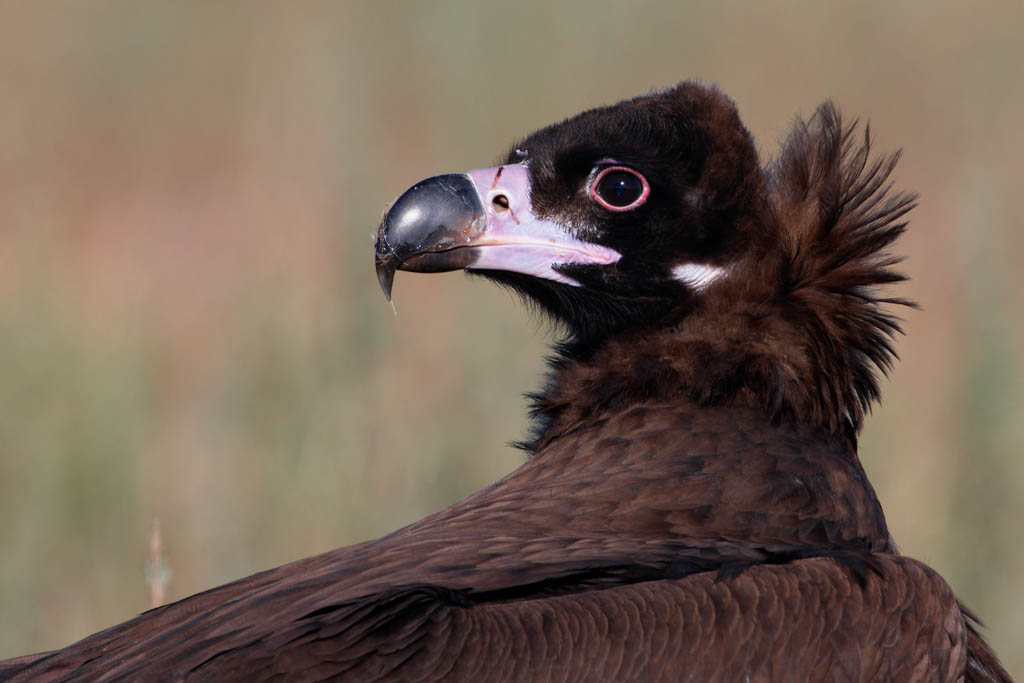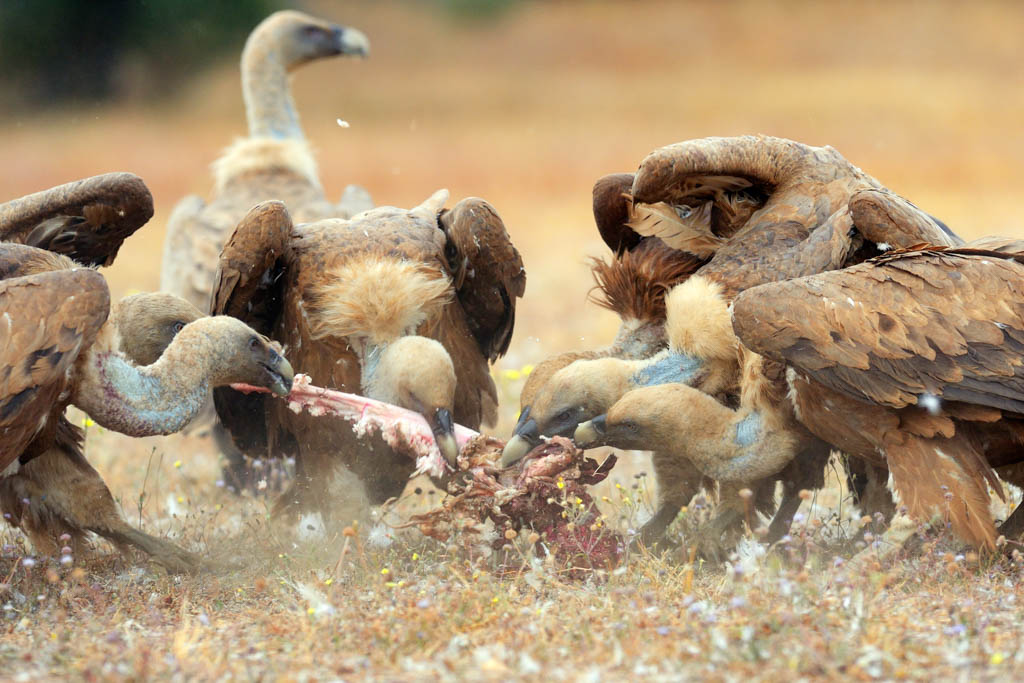Συντονιστής δικαιούχος:
Αρκτικόλεξο:
LIFE RE-Vultures
Κώδικας αναφοράς:
LIFE14 NAT/NL/000901 – A2
Διάρκεια:
5 χρόνια.
Έναρξη: 01.01.2016
Λήξη: 30.06.2021
Συνολικός προϋπολογισμός:
2,198,572 ευρώ
Συνεισφορά της ΕΕ:
1,648,015 ευρώ
Σε ολόκληρα τα Βαλκάνια έχει απομείνει μόνο μία αποικία μαυρόγυπα. Για τον λόγο αυτό, απαιτούνται ειδικές προσπάθειες για την προστασία και την επέκταση της αναπαραγόμενης αυτής αποικίας στη βουλγαρική πλευρά της Ροδόπης. Στο ελληνικό τμήμα της οροσειράς, οι μαυρόγυπες αναπαράγονται στο Εθνικό Πάρκο Δάσους Δαδιάς-Λευκίμης-Σουφλίου, όμως αναζητούν τροφή σε ολόκληρη τη διασυνοριακή περιοχή. Επιπλέον, σκοπός του προγράμματος είναι να συμβάλει στην προστασία του μοναδικού ενδημικού πληθυσμού μαυρόγυπα στη Βουλγαρία και των ελάχιστων αναπαραγόμενων ζευγαριών που έχουν απομείνει στην Βορειοανατολική Ελλάδα και εξερευνούν ολόκληρη την περιοχή αναζητώντας τροφή.
Οι δράσεις του προγράμματος θα συμβάλουν στη διατήρηση ενός σταθερού ή αυξανόμενου πληθυσμού από τουλάχιστον 35 ζευγάρια μαυρόγυπα και 80 ζευγάρια όρνιου.
Στόχος
Το πρόγραμμα LIFE για τους γύπες, εστιάζει στην αποκατάσταση και εξάπλωση του μαυρόγυπα και του όρνιου σε αυτό το τμήμα των Βαλκανίων. Κεντρικός στόχος του προγράμματος LIFE είναι η μείωση των σημαντικών απειλών, ώστε να καθίσταται δυνατή η διατήρηση και η αποκατάσταση των πληθυσμών του μαυρόγυπα και του όρνιου στη διασυνοριακή περιοχή Ελλάδας/Βουλγαρίας στην ανατολική Οροσειρά ης Ροδόπης.
Στόχοι του προγράμματος:
- Η αύξηση της γνώσης για τις αιτίες θνησιμότητας των γυπών, καθώς και της γνώσης για τη διασπορά και τις περιπλανήσεις του.
- Η μείωση της ενόχλησης, της δηλητηρίασης, της παράνομης θανάτωσης και της πιθανής προσβολής από μολυβδίαση.
- Η αύξηση της φυσικής τροφής για τους μαυρόγυπες και τα όρνια στη φύση.
- Η μείωση του κινδύνου θανάτου των γυπών λόγω ηλεκτροπληξίας.
- Η προώθηση τοπικών οικοτουριστικών πρωτοβουλιών για την ανάδειξη των γυπών και της άγριας ζωής στη Βουλγαρία.
- Η ενεργή συμμετοχή των κτηνοτρόφων στην προστασία και τη διάθεση τροφής για τους γύπες.
- Η ευαισθητοποίηση του κοινού για την προστασία των γυπών.
- Η διευκόλυνση της δικτύωσης με άλλους οργανισμούς προστασίας την άγριας ζωής.
Για την επίτευξη των στόχων αυτών, απαιτείται μεγάλος αριθμός δράσεων:
- Μελέτες για τη χρήση του χώρου του Μαυρόγυπα στα βουνά της Ροδόπης και την εύρεση πιθανά νέων φωλιών εκτός της γνωστής αποικίας.
- Μελέτες σχετικές με τη διασπορά και τις κινήσεις των γυπών, και αναζήτηση ζευγαριών που ενδέχεται να αναπαράγονται εκτός της γνωστής αποικίας.
- Μελέτη της κατάστασης υγείας μεγάλων γυπών, με επίκεντρο την μολυβδίαση και τα κτηνιατρικά φάρμακα.
- Αναγνώριση και σχεδιασμός επιχειρηματικών ευκαιριών σχετικών με τους γύπες.
- Σύσταση μονάδας από εκπαιδευμένους σκύλους για την πρόληψη των δηλητηριάσεων.
- Υποστήριξη τοπικών επιχειρήσεων που σχετίζονται με την παρατήρηση γυπών (συμπεριλαμβανομένης της κατασκευής επαγγελματικών κρυψώνων).
- Υποστήριξη τοπικών προϊόντων που σχετίζονται με τους γύπες.
- Μείωση των συγκρούσεων με πηγές ηλεκτρικού ρεύματος και των περιστατικών ηλεκτροπληξίας.
- Προώθηση της χρήσης μη μολύβδινα σκάγια από κυνηγούς.
- Η ανάπτυξη και εφαρμογή προγράμματος ευαισθητοποίησης για παιδιά και νέους από το κέντρο πληροφόρησης για τους γύπες.
Είδη-ομπρέλα
Ο μαυρόγυπας και το όρνιο θεωρούνται είδη-ομπρέλα. Η προστασία τους θα ωφελήσει σημαντικά και άλλα είδη αρπακτικών πτηνών με τα οποία μοιράζονται τις ίδιες περιοχές αναπαραγωγής και αναζήτησης τροφής, αλλά και κύριες απειλές, ειδικότερα την δηλητηρίαση που επιδρά αρνητικά στην πληθυσμιακή τους ανάπτυξη. Τα είδη αυτά, αποτελούν ένδειξη ενός υγιούς και ανέπαφου φυσικού περιβάλλοντος.

Μαυρόγυπας
Η μοναδική αποικία μαυρόγυπα στα Βαλκάνια βρίσκεται στο Εθνικό Πάρκο Δαδιάς-Λευκίμης-Σουφλίου (ΕΠ Δαδιάς), στο ελληνικό τμήμα της οροσειράς της Ροδόπης, περίπου 25 χιλιόμετρα από τα σύνορα με τη Βουλγαρία. Στα τέλη της δεκαετίας του ‘60, ο πληθυσμός στο ΕΠ Δαδιάς ήταν ήδη μικρός, με μόλις 4-5 ζευγάρια και 26 άτομα. Μεταξύ 1987 και 1993, ο πληθυσμός αυξήθηκε από 6 ζευγάρια σε 20,τα οποία αναπαράγονταν μόνο στο ΕΠ Δαδιάς, αποτελώντας τον μεγαλύτερο αναπαραγόμενο πληθυσμό στην Ελλάδα. Την περίοδο 1994- 2005, ο πληθυσμός παρέμεινε σταθερός στα 19 ± 2 ζευγάρια, ενώ από το 2006, έχει αυξηθεί στα 28±. Ο μεγαλύτερος αριθμός ζευγαριών που καταγράφτηκε τη τελευταία πενταετία είναι 35 ζευγάρια.
Έχοντας υπάρξει κοινός και ευρέως διαδεδομένος στο παρελθόν, σήμερα η αναπαραγωγή του μαυρόγυπα δεν θεωρείται τακτική στην Βουλγαρία. Η τελευταία καταγεγραμμένη αναπαραγωγή ήταν το 1993 στην Ζώνη Ειδικής Προστασίας του Studen Kladenets και την Ανατολική Ροδόπη, τις τελευταίες γνωστές περιοχές αναπαραγωγής του είδους στη Βουλγαρία. Σήμερα, το βουλγαρικό τμήμα της Ανατολικής Ροδόπης αποτελεί σημαντικό μέρος της ενδημικής περιοχής των μαυρόγυπων που αναπαράγονται στη Δαδιά, αλλά και πιθανός τόπος όπου μπορούν να εγκατασταθούν, και τελικά να αναπαραχθούν, ανήλικα πτηνά.

Griffon vulture
Το όρνιο ήταν ένα πολυπληθές και διαδεδομένο είδος στην Βουλγαρία, στις αρχές του 20ου αιώνα. Ωστόσο, μέσα σε λίγες δεκαετίες, έως τα μισά του αιώνα, το είδος, στο σύνολό του σε ολόκληρη την Βουλγαρία, έγινε εξαιρετικά σπάνιο και σχεδόν εξαφανίστηκε, κυρίως λόγω δηλητηριάσεων και εσκεμμένων θανατώσεων. Μεταξύ του 1960 και του 1970, οι τελευταίες γνωστές τοποθεσίες αναπαραγωγής του όρνιου είχαν εκλείψει και κάποιοι ειδικοί θεωρούσαν το είδος ως εξαφανισμένο στη Βουλγαρία.
Στην Ελλάδα, το όρνιο θεωρούταν το συνηθέστερο είδος αρπακτικού, στο παρελθόν. Τη δεκαετία του ‘80, ο πληθυσμός του υπολογιζόταν στα 400-450 αναπαραγόμενα ζευγάρια, 200 από τα οποία βρίσκονταν στην Κρήτη. Ενώ στην Κρήτη ο πληθυσμός παρέμενε σταθερός ή αυξανόταν, στην ηπειρωτική Ελλάδα κατέρρεε. Μετά το 1990, 13-15 αποικίες εξαφανίστηκαν, και παρατηρήθηκε μείωση πληθυσμού κατά τουλάχιστον 60% σε σχέση με τον μέχρι πρότινος καταγεγραμμένο, κυρίως λόγω δηλητηριάσεων. Σήμερα, υπάρχουν μόλις περίπου 20 ζευγάρια στη δυτική και βορειοανατολική ηπειρωτική Ελλάδα, και ο πληθυσμός τους εξακολουθεί να μειώνεται. Οι περιοχές του προγράμματος στην Ελλάδα – η Οροσειρά της Ροδόπης και οι πρόποδες της στην περιοχή του Έβρου – αποτελούν τα σημαντικότερα καταφύγια για τα όρνια στην ηπειρωτική Ελλάδα, φιλοξενώντας 7-8 ζευγάρια.
Κατάσταση προστασίας
Τα κύρια είδη-στόχοι του προγράμματος αυτού είναι ο μαυρόγυπας (Aegypius monachus) και το όρνιο (Gyps fulvus). Το όρνιο και ο μαυρόγυπας περιλαμβάνονται στο Παράρτημα 1 της Οδηγίας της ΕΕ για τα Πτηνά, στο Παράρτημα 2 της Σύμβασης για τα Μεταναστευτικά είδη (CMS), στο Παράρτημα 2 της Σύμβασης για την Προστασία της Άγριας Ζωής και του Φυσικού Περιβάλλοντος στην Ευρώπη (Σύμβαση της Βέρνης), και στο Παράρτημα 2 της Σύμβασης για το Διεθνές Εμπόριο Ειδών Άγριας Χλωρίδας και Πανίδας που απειλούνται με εξαφάνηση (CITES). Ο μαυρόγυπας κατηγοριοποιείται ως Σχεδόν απειλούμενο είδος στην Κόκκινη Λίστα της Διεθνούς Ένωσης για την Προστασία της Φύσης (IUCN).